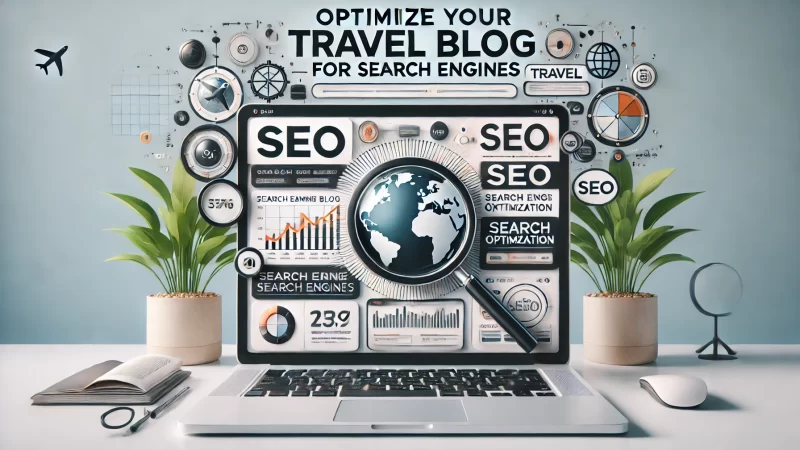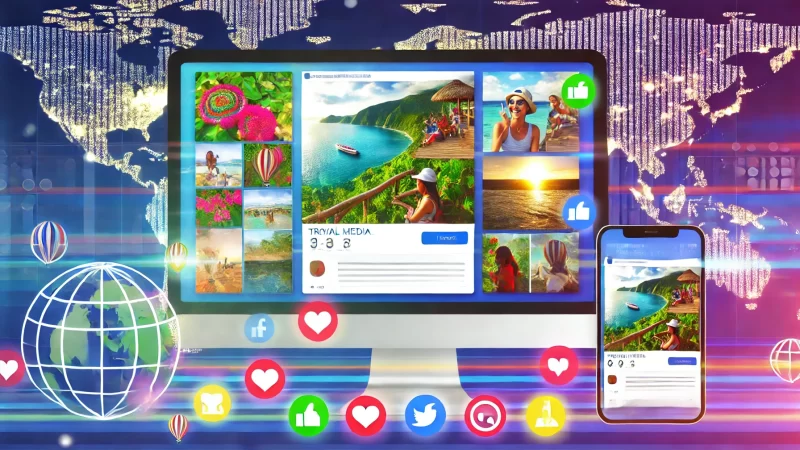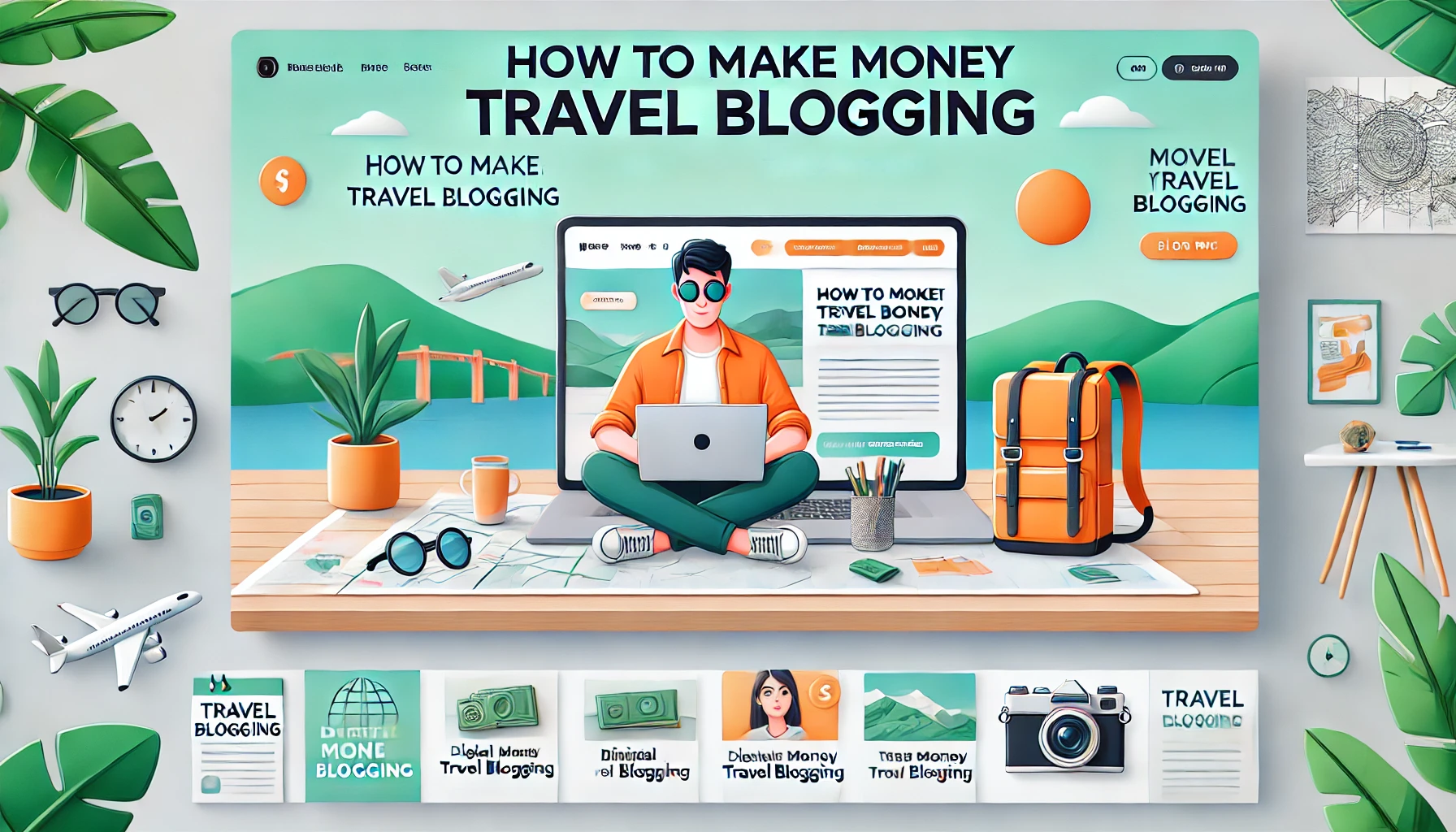Table of Contents
How can you turn your travel passion into profit? Wondering how to make money travel blogging, grow your audience, and sustain a life of adventure?
This guide will cover everything you need to know, from essential monetization methods to effective audience engagement strategies. Let’s dive into the exact steps to make your travel blog a profitable venture.
Start With Setting Up Your Travel Blog
Creating a successful travel blog starts with building a strong foundation. Setting up a travel blog involves careful planning, from choosing the right niche to selecting reliable hosting and designing a professional layout. Let’s break down each step.
Choose A Profitable Blogging Niche
Finding a niche is the first step in establishing a travel blog that stands out. I suggest picking a niche you’re passionate about but that also has market demand. A specific focus, like eco-travel, luxury travel, or solo backpacking, will attract a dedicated audience.
Selecting a niche also helps guide your content ideas and build a loyal reader base. When readers recognize you as an authority in a niche, they’re more likely to return. Consider what unique perspectives or experiences you can bring to your chosen area.
Researching the profitability of your niche is also essential. Some niches lend themselves better to monetization, like luxury travel or adventure tours. Explore affiliate programs and ad revenue potential in the niche before finalizing your choice.
Lastly, a profitable niche should be something you enjoy writing about consistently. The passion you bring to your topic will show in your content, creating a genuine connection with readers.
Select Reliable Blogging Platforms And Hosting
Choosing the right blogging platform and hosting service is vital for a smooth blogging experience. I recommend going with WordPress, as it offers flexibility and a vast range of plugins to enhance your blog’s functionality. For hosting, reliable options include Bluehost and WPengine.
Your hosting service will directly impact your blog’s loading speed and uptime. A slow website can frustrate visitors, making them leave. That’s why a dependable hosting provider is essential for keeping your audience engaged.
Security is also key when selecting hosting. Look for hosts that offer SSL certificates, backups, and security monitoring. Protecting your blog from data breaches builds trust with readers.
A scalable hosting plan will allow your blog to grow without interruptions. As traffic increases, you can upgrade to a plan that supports higher traffic and storage needs, keeping your blog performance strong.
Design A User-Friendly Travel Blog Layout
A clean, attractive layout makes a big difference in user experience. I suggest choosing a design that reflects your travel niche, whether minimalist for luxury travel or vibrant for adventure blogs. This visual identity will set the tone for readers.
The layout should prioritize navigation to keep visitors exploring your content. Organize categories and include a search bar to help readers find what they’re looking for. An intuitive layout keeps readers on your blog longer, improving your SEO.
Visuals are essential in travel blogging. Incorporate high-quality images and clear fonts to enhance readability. Including personal photos can make your blog feel more relatable and engaging, showcasing your journey.
Finally, ensure your layout is mobile-friendly. Many readers access travel blogs on mobile devices, so a responsive design will adapt your blog to any screen, providing a seamless experience across devices.
Build A Strong Brand Identity For Your Blog
A memorable brand identity helps your blog stand out in the crowded travel niche. I advise starting with a unique blog name and logo that reflect your personality and niche focus. A strong brand resonates with readers and builds loyalty over time.
Your brand identity extends to your writing style. Choose a tone that reflects your voice, whether humorous, adventurous, or insightful. This consistency in style will help readers feel a connection to your content and your journey.
Colors and fonts are also part of your brand. Pick a color palette that matches your niche—blues and greens work well for nature travel, while gold and black suit luxury themes. Consistent branding strengthens your blog’s visual appeal.
Branding goes beyond visuals; it’s about the value you bring to readers. Focus on delivering content that’s informative and authentic, establishing trust with your audience and reinforcing your blog’s unique identity.
Optimize Your Travel Blog For Search Engines

SEO is essential for attracting readers to your travel blog organically. With the right optimization strategies, your blog can appear on search engine results for key terms like “travel.” This section will cover effective SEO practices for travel blogs.
Use SEO Keywords Effectively In Content
Using SEO keywords naturally throughout your content is critical for ranking. I recommend placing primary keywords in the title, introduction, and subheadings to help search engines understand your topic.
Avoid stuffing keywords; instead, use variations to maintain readability. This technique enhances SEO without compromising user experience.
Incorporating keywords into image alt tags and URLs also boosts SEO. These small additions provide search engines with more context, improving your blog’s chances of ranking higher on relevant searches.
Write for readers first and search engines second. Engaging content that’s useful to readers will naturally rank well, so focus on creating valuable insights while blending keywords seamlessly.
Create SEO-Optimized Blog Titles And Meta Descriptions
SEO-friendly titles and meta descriptions are essential for boosting click-through rates. I suggest keeping titles between 55-60 characters, using power words to capture interest, like “Ultimate Guide” or “Essential Tips.” These make your title more appealing in search results.
Meta descriptions should be concise summaries of your content, incorporating primary keywords naturally. A clear meta description lets readers know what to expect, increasing the chance they’ll click on your blog post.
Your title tag and meta description also create a strong first impression. Optimized, descriptive text can draw more readers, improving visibility and engagement with your blog.
Use unique descriptions for each post. This way, each piece of content stands out in search results, and search engines can better understand the content’s specific focus.
Boost Blog Speed And Mobile Usability
Page speed and mobile usability are critical for retaining readers. I advise using tools like Google PageSpeed Insights to check your blog’s performance. Compressing images, enabling browser caching, and using a lightweight theme will improve speed.
Mobile responsiveness is equally important since a significant portion of traffic comes from mobile users. A mobile-friendly blog retains readers and reduces bounce rates, both of which positively impact SEO.
Avoid complex layouts and excessive plugins, as these can slow down loading times. A streamlined website design ensures that pages load quickly and keep readers engaged with your content.
Website speed directly affects your rankings. The faster your site loads, the better its chances of appearing at the top of search results, bringing more visitors to your blog.
Leverage Internal Linking Strategies For Traffic
Internal links encourage readers to explore more of your content, improving engagement. I suggest linking to related posts within each blog entry, guiding readers to relevant articles and keeping them on your site longer.
Internal links also help search engines understand the structure of your site. When Google sees links to other content, it recognizes connections between topics, strengthening your blog’s SEO profile.
Use anchor text that’s natural and descriptive, helping readers understand where the link will take them. Avoid generic phrases like “click here” and opt for specific keywords related to the content.
Adding links to cornerstone content, such as essential guides or popular posts, is another great way to direct traffic. These articles can become pillars that help readers navigate your blog and find valuable insights.
Create High-Quality Content For Your Blog
Creating high-quality content is essential for attracting readers and keeping them engaged. By crafting engaging stories, using visuals, and expanding your reach, you can build a blog that stands out and provides real value to readers.
Develop Engaging Travel Stories And Guides
Developing captivating travel stories and informative guides will keep readers coming back. I suggest sharing personal experiences, tips, and insights that make your posts feel relatable and unique. This approach establishes a genuine connection with readers.
Creating well-structured guides also helps readers navigate unfamiliar destinations. Include practical details like travel routes, budgeting tips, and local highlights. This makes your blog a go-to source for useful travel information.
Adding a personal touch to your stories brings them to life. Describe your emotions, encounters, and surprises along the journey. Readers will appreciate this authenticity, making your stories memorable.
Crafting stories that resonate with readers requires focusing on their needs and interests. Keep posts engaging by blending storytelling with useful advice, striking a balance between personal reflections and practical tips.
Incorporate Stunning Visuals To Increase Engagement
I recommend using high-quality images to enhance your content and captivate readers. Visuals can transport readers, giving them a taste of the destinations you describe. Stunning photos add depth to your stories and make posts more shareable.
Visuals can include not only photos but also maps, infographics, and videos. Each adds unique value, helping readers engage with your content in multiple ways. This diversity keeps your blog visually interesting and informative.
Think about the colors, lighting, and composition when choosing visuals. Bright, clear images work best, making your posts look professional. This attention to quality reflects your commitment to providing a premium reader experience.
Integrating visuals effectively involves balancing image size with site speed. I suggest compressing files to retain quality without slowing down your page, ensuring readers enjoy smooth, uninterrupted browsing.
Write Guest Posts To Expand Blog Reach
Writing guest posts on established blogs expands your reach and brings new readers to your site. Focus on crafting high-quality content that showcases your expertise. I suggest selecting platforms related to travel to maximize relevance.
Guest posts help establish you as an authority in your niche. By sharing insights on other blogs, you can build credibility and drive traffic to your site. Look for blogs with engaged audiences who might be interested in your content.
Engage with the audience on the host blog by replying to comments on your guest post. This interaction can spark interest and encourage readers to check out your blog. Engaged followers are more likely to become loyal readers.
Follow each host blog’s style guidelines to ensure your post aligns with their audience’s expectations. Consistency in quality will help you build a strong reputation, encouraging more collaboration opportunities.
Research And Write SEO-Friendly Blog Posts
Creating SEO-friendly posts is vital for reaching a broader audience. I suggest researching keywords that match user search intent, helping you craft content readers are actively seeking. This boosts visibility and attracts organic traffic.
Including primary and secondary keywords strategically improves your ranking without compromising readability. I recommend placing keywords in titles, headers, and naturally within the text. This ensures search engines recognize your content’s relevance.
In-depth posts rank better, so provide valuable, detailed content on each topic. Address common questions and provide thorough explanations, making your blog a helpful resource that encourages readers to stay and explore.
Regularly updating content with fresh information signals to search engines that your blog is current and reliable. This practice keeps your SEO strong and reinforces your blog’s position as an up-to-date travel resource.
Build An Engaged Travel Audience

Building an engaged audience is crucial for growing your blog’s influence. By connecting with readers through social media, email, and community interactions, you create a loyal community that values and shares your content.
Promote Blog Content On Social Media Platforms
Social media is an excellent way to attract readers to your travel blog. I recommend posting regularly on platforms like Instagram, Facebook, and Pinterest, as they’re popular among travel enthusiasts. This exposure boosts engagement with your content.
Using captivating captions and hashtags will expand your reach on these platforms. Readers searching for travel inspiration are more likely to find your posts, leading to higher blog traffic. Hashtags specific to destinations or travel niches work well.
Sharing behind-the-scenes content on social media builds a personal connection. When followers see a bit of your travel routine or planning process, they feel involved in your journey, which fosters loyalty to your brand.
Engaging with followers through comments and stories keeps them connected. Answer questions and ask for feedback to make your audience feel valued, creating a stronger, more interactive community.
Create An Email List For Direct Audience Communication
An email list is a valuable tool for direct communication with your audience. I recommend setting up an opt-in form on your blog to capture email addresses, allowing you to reach readers with personalized content and updates.
Regular newsletters keep your blog on readers’ minds, increasing the chances of repeat visits. Share recent posts, travel tips, and exclusive insights in each email, providing subscribers with value that keeps them engaged.
Segmenting your email list allows you to tailor content for specific reader interests, improving engagement rates. For instance, some subscribers may prefer content on budgeting travel, while others might enjoy luxury tips.
Personalize emails by using readers’ names and relevant topics, making each email feel direct and friendly. This simple touch can enhance the relationship you build with subscribers, making them loyal followers of your blog.
Engage Through Community Comments And Feedback
Engaging with your readers in the comment section builds a supportive community around your blog. I suggest responding to comments promptly, answering questions, and acknowledging feedback, showing readers you value their interaction.
Encouraging discussions in your comments section boosts engagement and gives readers a reason to return. When readers see active conversations, they feel more inclined to participate, which strengthens your blog’s community.
Handling constructive criticism professionally improves credibility. Addressing concerns transparently shows readers you are open to feedback and committed to delivering high-quality content.
Regularly asking readers for topic suggestions or feedback keeps content relevant. This approach not only engages readers but also ensures your blog reflects the interests of your audience, increasing long-term loyalty.
Host Webinars And Q&As To Boost Engagement
Hosting webinars or Q&A sessions allows you to interact with your audience in real-time. I suggest choosing relevant travel topics that allow you to share insights and answer questions directly, creating a dynamic, engaging experience.
Webinars are an opportunity to share deeper knowledge, providing value that goes beyond blog posts. Consider covering travel planning, budgeting, or niche-specific topics to attract a targeted audience interested in those areas.
Q&A sessions help build trust by allowing readers to connect with you personally. Answering their questions openly gives your blog a human touch, making readers feel more connected to your journey and insights.
Promoting these events on social media and through email helps attract attendees. Send reminders leading up to the event to ensure strong participation, which enhances the experience for everyone involved.
Monetize Your Travel Blog With Affiliate Marketing
Affiliate marketing offers a rewarding way to earn from your travel blog by promoting relevant products and services. This approach allows you to share recommendations with your audience and earn commissions on purchases made through your affiliate links.
Select High-Commission Travel Affiliate Programs
Choosing high-commission affiliate programs can maximize your earnings per sale. I recommend looking for travel programs that offer competitive rates, such as those in hotel bookings, travel gear, or tour packages. This ensures a valuable return on your effort.
Researching affiliate programs also involves evaluating brand credibility. Readers trust your recommendations more when they’re connected to reputable brands. Reliable partnerships build confidence in your blog, encouraging followers to make purchases through your links.
Consider the relevance of each program to your audience. Promoting products that align with your niche, like eco-friendly gear for sustainable travel blogs, ensures higher engagement and conversion rates, as they resonate with readers’ interests.
Selecting a few programs with generous commissions allows you to focus on quality over quantity. Concentrating on these will simplify your strategy, making it easier to create content that genuinely promotes these products.
Write Reviews And Guides With Affiliate Links
Writing in-depth reviews and guides that include affiliate links can boost engagement and conversions. I suggest creating helpful content like “Top Travel Gadgets” or “Best Hotels for Budget Travelers.” This informative format encourages readers to click your links.
Reviews should be honest and thorough, covering both pros and cons. Transparency builds trust with readers, making them more likely to follow your recommendations. This authentic approach improves the chances of earning consistent affiliate revenue.
Guides that address common reader questions perform well. For instance, a guide on “Packing Essentials” for your niche can be incredibly valuable. Including affiliate links to recommended products feels natural and serves readers’ needs directly.
Positioning affiliate links within the flow of content is key. Aim for a seamless integration that doesn’t feel forced, making the content enjoyable while still maximizing potential earnings through strategic placement.
Use Affiliate Links In Travel Resource Pages
A dedicated resource page is a great place to compile useful affiliate links. I recommend creating a “Travel Resources” page that includes essentials like booking sites, travel insurance, and gear recommendations. This organized approach serves as a go-to resource for readers.
A resource page should cover various needs, from budget travel options to luxury accommodations. By addressing diverse interests, you can appeal to a broader audience, making your page a valuable asset for readers at different experience levels.
Include short descriptions for each affiliate link, explaining how each product or service benefits travelers. This added context helps readers understand why they should consider these options, increasing the likelihood of conversions.
Regularly updating this page keeps it relevant and valuable. As you discover new tools or services, adding them to your resource page ensures readers always have access to fresh, reliable recommendations.
Track And Optimize Affiliate Conversions
Tracking and optimizing affiliate performance helps you identify which links generate the most revenue. I suggest using tools like Google Analytics or ClickMagick to monitor click-through rates and conversion data, providing insight into what works best.
Analyzing which posts drive the most affiliate clicks allows you to refine your content strategy. Focus on creating more of the content types that yield higher conversions, whether that’s reviews, guides, or resource pages.
Experiment with link placement to find what resonates with readers. Testing positions like mid-article vs. end-of-article can reveal which placement leads to more clicks, optimizing your blog for maximum affiliate income.
Regularly reviewing performance also helps you decide which affiliate programs are worth keeping. If certain programs aren’t delivering results, replacing them with better-performing ones strengthens your blog’s earning potential.
Earn Through Sponsored Content And Partnerships

Sponsored content and partnerships offer a lucrative way to earn from your blog. These collaborations involve promoting brands and products that align with your travel niche, providing valuable exposure to both you and your partners.
Attract Brands For Sponsored Travel Posts
To attract sponsors, I suggest establishing a strong online presence that showcases your blog’s niche and value. Brands look for bloggers with engaged audiences, so building a solid follower base on social media and your blog is essential.
Highlight your blog’s unique angle, like luxury travel or budget-friendly tips. This distinction helps brands see the potential fit with their own values, increasing the chances of landing partnerships that align with your audience.
Showcase your engagement metrics to potential sponsors. Highlighting active comments, shares, and social media engagement can demonstrate your influence, making you a more appealing partner for brands looking to boost their visibility.
Consider creating a media kit with stats, demographic information, and past collaborations. A polished media kit gives brands a quick overview of your blog’s reach and credibility, streamlining the negotiation process.
Craft High-Quality Sponsored Blog Content
Creating high-quality sponsored content involves crafting posts that seamlessly integrate brand messages. I recommend maintaining authenticity by sharing genuine experiences or product uses, making the content relatable rather than overtly promotional.
Choose brands that resonate with your blog’s audience to keep content relevant. For example, if you focus on adventure travel, partnering with outdoor gear brands will feel natural and authentic to readers, encouraging higher engagement.
Balance sponsored content with your regular posts to avoid overwhelming readers with promotions. Mixing sponsored and organic content keeps your blog diverse and maintains reader trust, ensuring they continue to find value in your posts.
I suggest using storytelling to incorporate sponsors naturally. Rather than a straightforward product pitch, weave the brand into your travel experience, making the content enjoyable while promoting the sponsor effectively.
Utilize Social Media For Sponsorship Opportunities
Social media is a powerful tool for showcasing sponsored content. I advise posting engaging content on platforms like Instagram and Facebook, where visuals can bring the brand message to life. This approach enhances reach and engagement with your audience.
Using branded hashtags and tags in posts boosts visibility, making it easier for sponsors to track campaign success. Hashtags also help attract new followers who share similar interests, broadening your audience and potential future sponsorships.
Engage with followers in the comments on sponsored posts, answering questions or providing additional information. This interaction builds trust, showing that you genuinely believe in the brands you promote.
Feature behind-the-scenes glimpses of sponsored experiences, giving followers a personal view of the collaboration. This behind-the-scenes content adds authenticity, making followers feel more connected to your brand and the sponsor.
Negotiate Lucrative Sponsorship Contracts
Negotiating sponsorship contracts ensures fair compensation for your work. I recommend discussing terms like post frequency, platform coverage, and exclusivity to create a clear agreement. This approach sets mutual expectations and avoids misunderstandings.
Valuing your audience and engagement metrics can help justify your rates. When sponsors see the influence you hold, they’re more likely to agree to fair compensation, recognizing the value of reaching your blog’s dedicated readers.
Ensure contracts specify usage rights and content ownership, especially for images. Clarifying these details in advance protects your content and defines how sponsors can use it, giving you control over your blog’s branding.
Building long-term partnerships can provide steady income. I suggest focusing on relationships that align with your values and audience, fostering ongoing collaborations that support your blog’s growth while enhancing your readers’ experience.
Generate Revenue With Digital Products
Offering digital products is an excellent way to create a steady income from your travel blog. From ebooks to memberships, these products allow you to monetize your expertise while providing valuable resources directly to your audience.
Sell Travel Ebooks And Guides On Your Blog
Selling travel ebooks or guides allows you to share your insights and earn revenue. I suggest creating content that answers specific reader questions, like “Budget Travel in Europe” or “Solo Backpacking Essentials,” offering practical advice in an easy-to-download format.
Ebooks offer a lasting source of income and can be updated over time. Covering evergreen travel topics keeps your content relevant, allowing new readers to benefit from your expertise while adding to your income with each sale.
I recommend promoting your ebook on social media and your blog’s email list. This targeted approach reaches readers interested in in-depth guidance, increasing the likelihood of conversions as they trust your knowledge on travel.
Pricing ebooks affordably while delivering high-quality content makes them attractive to readers. Offering discounts or bundling guides together can further boost sales, making it easy for your audience to access valuable information.
Offer Downloadable Itineraries And Travel Checklists
Creating downloadable itineraries and checklists provides readers with ready-to-use resources. I suggest developing itineraries for popular destinations, outlining daily plans and must-see spots, as well as essential checklists like “Packing for Adventure Travel” or “Family Travel Essentials.”
Downloadable itineraries add convenience for readers planning trips. Providing step-by-step guides helps them save time and reduces travel planning stress, making your blog a go-to source for organized, travel-ready content.
Checklists are ideal for addressing specific travel needs, like packing light or navigating airport logistics. These practical tools enhance your audience’s travel experience, reinforcing your value as a trusted travel advisor.
Offering exclusive downloads as opt-ins for your email list can boost engagement and grow your subscriber base. This approach benefits readers and positions you as a reliable resource, supporting your long-term blog growth.
Create Paid Memberships For Exclusive Content
Paid memberships allow you to share premium content with loyal readers. I recommend offering exclusive benefits, like insider travel tips, destination guides, or monthly webinars, giving members access to value beyond your free content.
Memberships encourage a dedicated community and provide a stable income stream. By focusing on in-depth resources or members-only events, you can offer content that’s more tailored and interactive, which keeps members engaged.
Think about tiered memberships to accommodate different budgets. Offering basic and premium plans lets readers choose based on their needs, making your membership accessible while providing advanced perks to those who invest more.
Regularly adding fresh content for members keeps them interested and subscribed. This consistent value shows your commitment, creating a community of travelers who rely on your exclusive insights for their next adventures.
Develop And Sell Online Travel Courses
Creating online travel courses lets you share specialized knowledge. I suggest developing courses on topics like “Travel Photography Essentials” or “How to Start a Travel Blog,” breaking down each lesson into manageable, actionable modules.
Courses offer a comprehensive way to share your expertise, appealing to readers who want deeper learning. By covering topics thoroughly, you can help readers gain skills they can apply on their journeys or in their own blogs.
Hosting courses on platforms like LearnWorlds or LifterLMS enhances accessibility, letting students access lessons anytime. This flexibility makes your course more attractive, encouraging a wider audience to enroll and learn from you.
Adding personal touches, like live Q&As or one-on-one feedback, increases course value. These interactions foster a stronger connection with students, making your course feel more personalized and supportive.
Maximize Revenue Using Display Ads

Display ads provide a straightforward way to earn income by monetizing your blog’s traffic. By placing targeted ads on your site, you can generate revenue every time a reader views or clicks on them, enhancing your overall earnings.
Sign Up With Ad Networks To Earn From Views
Joining ad networks like Monetag or Adsterra lets you monetize your blog easily. These networks match ads to your content, serving relevant ads that engage your readers, leading to higher revenue from views or clicks.
Choosing an ad network that aligns with your traffic volume is essential. Some networks require minimum monthly views, so I suggest selecting one that fits your current reach to start earning without limitations.
Ad networks often offer various ad types, including display, video, and native ads. Experimenting with formats that suit your blog’s layout can improve user experience and maximize engagement with the ads shown.
I recommend testing ad placements on different pages to see where they perform best. Finding spots that naturally catch readers’ attention without disrupting content flow can increase ad views and overall earnings.
Optimize Ad Placement For Maximum Revenue
Optimizing ad placement ensures you get the most out of each view. I suggest placing ads near popular content areas, like within posts or at the top of the page, where readers are likely to notice them without feeling overwhelmed.
Using heat maps to track where readers engage most can guide you in choosing ad spots. This insight helps you strategically place ads where they’ll get maximum visibility, enhancing revenue without cluttering the page.
Balancing ads with content keeps readers focused on your blog’s value. Avoiding excessive ads maintains a clean look, ensuring that your readers enjoy their visit without interruptions, making them more likely to return.
Consider ad size and type when positioning them. Large or dynamic ads can catch attention effectively, but subtle placements can work just as well in enhancing user experience and encouraging engagement.
Test Ad Formats For Better Engagement Rates
Testing various ad formats helps identify what appeals most to your readers. I recommend experimenting with formats like video ads, carousel ads, or interactive banners to capture attention in different ways and increase engagement.
Video ads often perform well as they’re visually engaging. These ads can attract attention without requiring readers to leave the page, keeping them engaged with both your content and the ad.
Interactive ads, like carousels, add an engaging element that can entice readers to click through. This format allows readers to explore products or services, providing a more engaging experience than static ads.
I suggest running A/B tests on formats to compare performance. Testing allows you to refine your ad strategy based on real data, choosing the formats that yield the best results without guessing what will work best.
Analyze Ad Performance And Adjust Accordingly
Regularly analyzing ad performance helps you stay on track with revenue goals. I suggest reviewing metrics like click-through rate and viewability, allowing you to see which ads perform best and adjust placements for maximum impact.
Evaluating page load time is essential, as ads can sometimes slow down your site. Keeping an eye on speed ensures that ads enhance, rather than detract from, user experience, retaining readers and improving SEO.
Consider seasonality when analyzing performance, as some ads may perform better at different times of the year. Adjusting based on trends allows you to make the most of high-demand periods, maximizing ad revenue.
Use the data to refine your strategy continuously. Adjust placements, formats, and networks as needed, always focusing on enhancing user experience while keeping ad revenue steady. This dynamic approach keeps your blog optimized for income.
Leverage Freelance Services Related To Travel
Offering freelance services is an effective way to monetize your travel expertise. From photography to consulting, these services allow you to share your skills with others while creating a diverse income stream that complements your travel blog.
Offer Travel Photography And Video Services
Providing photography and video services can be highly rewarding. I suggest building a portfolio showcasing your best travel shots, as this visually appealing collection demonstrates your talent and can attract clients looking for high-quality content.
Offering both photos and videos expands your client base. Some clients may need still images, while others seek videos for promotional purposes. By offering both, you appeal to a broader market, increasing potential revenue from each trip.
Consider collaborating with travel brands for specific projects. Brands often need fresh visuals for their marketing, and hiring a travel photographer saves them time. Your unique travel perspective can bring their products to life in exciting settings.
Establishing a rate structure helps streamline your services. Offering packages for photo sessions or video edits makes it easier for clients to choose, while ensuring you’re compensated fairly for your expertise and time.
Sell Writing Services To Travel Publications
Writing for travel publications can be a great way to monetize your skills. I recommend pitching articles to magazines or websites that align with your expertise, such as adventure travel, luxury destinations, or budget trips, increasing your chances of acceptance.
Offering unique perspectives or niche topics makes your articles more appealing to editors. When publications see that your expertise matches their audience’s interests, they’re more likely to commission pieces, allowing you to earn while building credibility.
Create a portfolio with writing samples to showcase your style and knowledge. Editors look for writers who can deliver engaging, well-researched content. A polished portfolio demonstrates your professionalism and commitment to quality.
Freelancing for multiple publications can diversify your income. Each platform offers a unique audience, expanding your reach as a travel expert. This diversity also keeps your work dynamic and your writing style adaptable.
Provide Consulting Services For Aspiring Bloggers
Offering consulting services to new bloggers is a rewarding way to share your knowledge. I suggest focusing on areas like niche selection, content strategy, or SEO tips, providing actionable insights to help beginners launch successful blogs.
One-on-one consultations allow you to address specific questions and provide tailored advice. Aspiring bloggers appreciate personal guidance, making your expertise valuable. This personalized approach makes clients feel supported on their blogging journey.
Creating a structured plan for each consultation keeps sessions productive. Outline key topics to cover and ensure clients leave with a clear action plan, reinforcing the value of your guidance and increasing satisfaction.
Offering group workshops is another effective format. Teaching multiple bloggers at once helps more people while creating a scalable income stream. Workshops can cover essentials like monetization strategies or building audience engagement.
Offer SEO And Social Media Management Services
SEO and social media management are high-demand skills in travel blogging. I recommend offering these services to bloggers or small travel brands looking to grow their online presence, as your expertise can help them reach larger audiences.
SEO services, like keyword research or content optimization, improve clients’ search visibility. Helping clients rank higher on search engines increases their organic traffic, making your expertise an invaluable resource for their growth.
Social media management focuses on building engagement and audience growth. Creating and scheduling posts, researching hashtags, or running campaigns allows clients to maintain an active presence while benefiting from your marketing knowledge.
Offering bundled SEO and social media services provides clients with a comprehensive growth strategy. When combined, these skills amplify results, making your services attractive to those looking to boost both traffic and engagement.
Track And Scale Your Blog’s Growth

Monitoring and scaling your blog’s growth is key to long-term success. Tracking analytics, optimizing content, and experimenting with new income streams all play a role in enhancing your blog’s reach and revenue potential.
Use Analytics To Monitor Blog Traffic And Engagement
Analytics tools like Kissmetrics offer insights into your blog’s performance. I recommend checking traffic sources, page views, and bounce rates regularly, allowing you to see what’s working and make data-informed adjustments to your strategy.
Tracking engagement metrics reveals which content resonates with readers. For instance, high engagement on specific topics may signal a demand for related posts, helping you refine your content calendar based on real audience interests.
Understanding traffic sources shows where readers are finding your blog. Knowing whether they arrive from search engines, social media, or referrals helps you focus efforts on channels with the highest impact, enhancing your promotional strategy.
Setting up goals in analytics lets you measure conversions, like newsletter sign-ups or ebook downloads. These insights track your progress toward business objectives, enabling you to optimize efforts for better results.
Optimize Content Based On Audience Behavior
Content optimization boosts engagement and visibility. I suggest using analytics to identify high-traffic posts, then updating these with fresh information or keywords. This renewal helps maintain relevance and keeps your top content performing well.
Enhancing readability can improve user experience. Shorter paragraphs, headers, and bullet points make content easier to read, keeping visitors engaged. Adjusting content structure helps retain readers, increasing their time on your site.
Optimizing for SEO involves adding or refining keywords. If analytics show keywords that drive traffic, incorporate these into older posts to attract more readers searching for similar terms. This approach strengthens your blog’s SEO without extra content creation.
Internal linking directs readers to related posts, enhancing navigation and session time. Adding links to popular articles keeps readers exploring your site, improving engagement and boosting your SEO rankings as visitors delve deeper into your content.
Experiment With New Revenue Streams For Growth
Exploring new income streams diversifies your revenue. I suggest trying affiliate marketing, digital products, or sponsored content, which provides opportunities to earn from different sources, helping reduce dependence on a single income stream.
Testing various affiliate programs can reveal what resonates with your audience. If certain products align with readers’ needs, promoting them can boost conversions, turning recommendations into consistent income without disrupting your content’s flow.
Launching digital products allows you to earn directly from your expertise. Ebooks, guides, or webinars cater to readers seeking deeper insights, generating revenue while adding value to your blog as a comprehensive travel resource.
Collaborating on sponsored posts expands your revenue potential. Partnering with brands lets you introduce new services or products to your audience, and thoughtful collaborations can enhance your blog’s content while supporting financial growth.
Scale Marketing Efforts For Higher Revenue
Scaling your marketing drives growth in traffic and revenue. I recommend focusing on strategies like email marketing, SEO improvements, and social media campaigns, each targeting specific goals to maximize your blog’s visibility and earnings.
Email marketing builds a direct line to your audience. I suggest sending regular updates, exclusive offers, or new content highlights, keeping readers engaged and driving repeat visits, which positively impact both engagement and conversions.
SEO improvements boost search traffic. Refreshing keywords and updating older posts enhance your visibility, attracting new readers who are searching for content in your niche. Effective SEO keeps traffic steady and brings consistent growth.
Social media campaigns attract new audiences and increase brand awareness. Running promotions or collaborating with influencers expands reach, bringing fresh traffic to your blog. Social engagement strengthens your online presence, supporting long-term growth.






